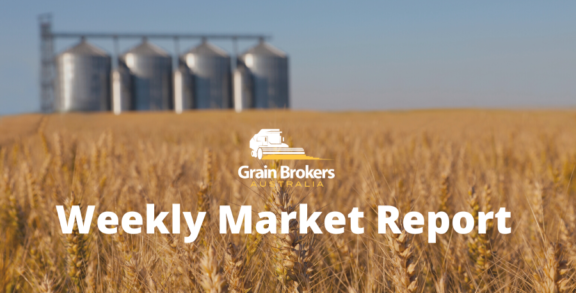
Grain Brokers Australia Weekly Market Report
by Peter McMeekin – 16th October, 2018
During the second week of each month of the year the United States Department of Agriculture (USDA) release their World Agricultural Supply & Demand Estimates (WASDE). The report provides the USDA’s comprehensive forecasts of supply and demand for both US and global crops such as wheat, rice, coarse grains, oilseeds and cotton.
In the days leading up to the report, the trade and speculators hypothesize about the numbers and position their trading books accordingly. In the days following the report the same people analyze the numbers, look for the holes (trading opportunities) and reposition accordingly.
There are two things for members to note about the monthly report. Invariably, there are surprises, and the USDA tends to be very slow to react to supply and demand changes outside of the US. When it comes to the rest of the world, it seems they are only concerned about being correct at the conclusion of the season rather than reflecting the production and consumption fluctuations within the season as they do with the US projections.
Take the Australian production numbers in last week’s report, for example. Wheat was decreased by only 1.5 million metric tonne (MMT) to 18.5MMT. Most of the domestic grain trade threw that number away more than a month ago and are probably around 16MMT, or lower today. Even that is possibly on the high side.
The Grain Industry Association of Western Australia (GIWA) released their latest crop report on Saturday and they have estimated wheat production at 8.15MMT, slashing almost 2MMT off their September estimate. That is a huge (maybe too huge) decrease and reflects the damage done by the late August and mid-September frosts and the extremely low rainfall in September – the most critical month for most regions.
Frosts and the dry September on the east coast have only added insult to injury for grain growers throughout Queensland, New South Wales and Victoria. With the decline in Victorian production in recent weeks combined with the huge area cut for hay, we expect that those three states will struggle to harvest more than 4MMT of wheat.
As South Australian members know, the state’s winter crop has not been immune to the issues that have beset the rest of the country in recent months, and harvest potential has suffered as a result. If we call wheat production in the Festival State 2.35MMT, and we believe the 20% drop in Western Australia, then that brings the total Australian production number to only 14.5MMT, 4MMT less than the USDA. That is scary!
Even scarier is that the USDA still has Australia in for 13MMT of wheat exports based on their optimistic production number and an unrealistically high carry in figure of 5.4MMT. The iconic Australian movie “The Castle” comes to mind here as we think Darryl Kerrigan would have a few words of wisdom in this situation.
The surprises continued on the barley front with the Australian production and export estimates left unchanged month-on-month at 7.8MMT and 5.8MMT respectively. Locally, most in the industry would have production in the region of 6MMT (with 60% of that in Western Australia) and exports around 3MMT.
The USDA’s optimistic Australian theme continued into oilseeds with the Australian canola crop predicted to be 2.9MMT. If the Western Australian crop is 1.3MMT, South Australia 0.3MMT and New South Wales and Victoria 0.6MMT combined, that comes to only 2.2MMT. There is a lot of pain in those numbers for the east coast crusher.
Rain in parts of southern Queensland and northern New South Wales over the past week has sorghum on the lips of many growers, traders and consumers. Whilst the falls have been quite patchy, and not enough to see a widescale plant at this stage, we are now seeing some of the gaps filled in, particularly on the inner Darling Downs.
We have to remember that rainfall in the summer cropping regions of Queensland and northern New South Wales has been well below average since the bumper crop in 2016. As result, the soil was bone dry and most regions would require at least 100mm to provide enough certainty for a large planting program.
That said, rain, after such a long dry spell, always brings optimism and sorghum growers will certainly be getting prepared to plant as soon as they have an adequate soil moisture profile. Undoubtedly, some will go early and take a punt on a portion of their area as the first sorghum off in the New Year will most likely command a premium.
Last week’s grain prices also reflected the change in the weather pattern, particularly in southern Queensland, the biggest feed grain demand region in Australia. Wheat and sorghum values delivered Darling Downs for March 2019 dropped around $15 to $450 and $370 respectively. Barley fell around $5 and is trading around $15 under wheat.
The size of the sorghum crop is the critical question here. At this stage in the season, production in the vicinity of 2MMT would be realistic. However, the rains need to continue, and they need to be far more widespread. If they haven’t arrived by mid-November, and some of the crop does not get planted, then production estimates will start to fall.
Consumer reaction will also be interesting. The Queensland feedlots have preferred wheat over sorghum for a number of years now, with the poultry sector the biggest sorghum consumer. High wheat prices and a substantial sorghum discount will certainly provide plenty of incentive to switch, as long as there is supply certainty for an extended period of time. The problem is, we are not remotely close to that scenario at this early stage in the northern wet season. Your broker will continue to keep you posted as consumers react.
Peter McMeekin is a consultant to Grain Brokers Australia. Call 1300 946 544 to discuss your grain marketing needs.





